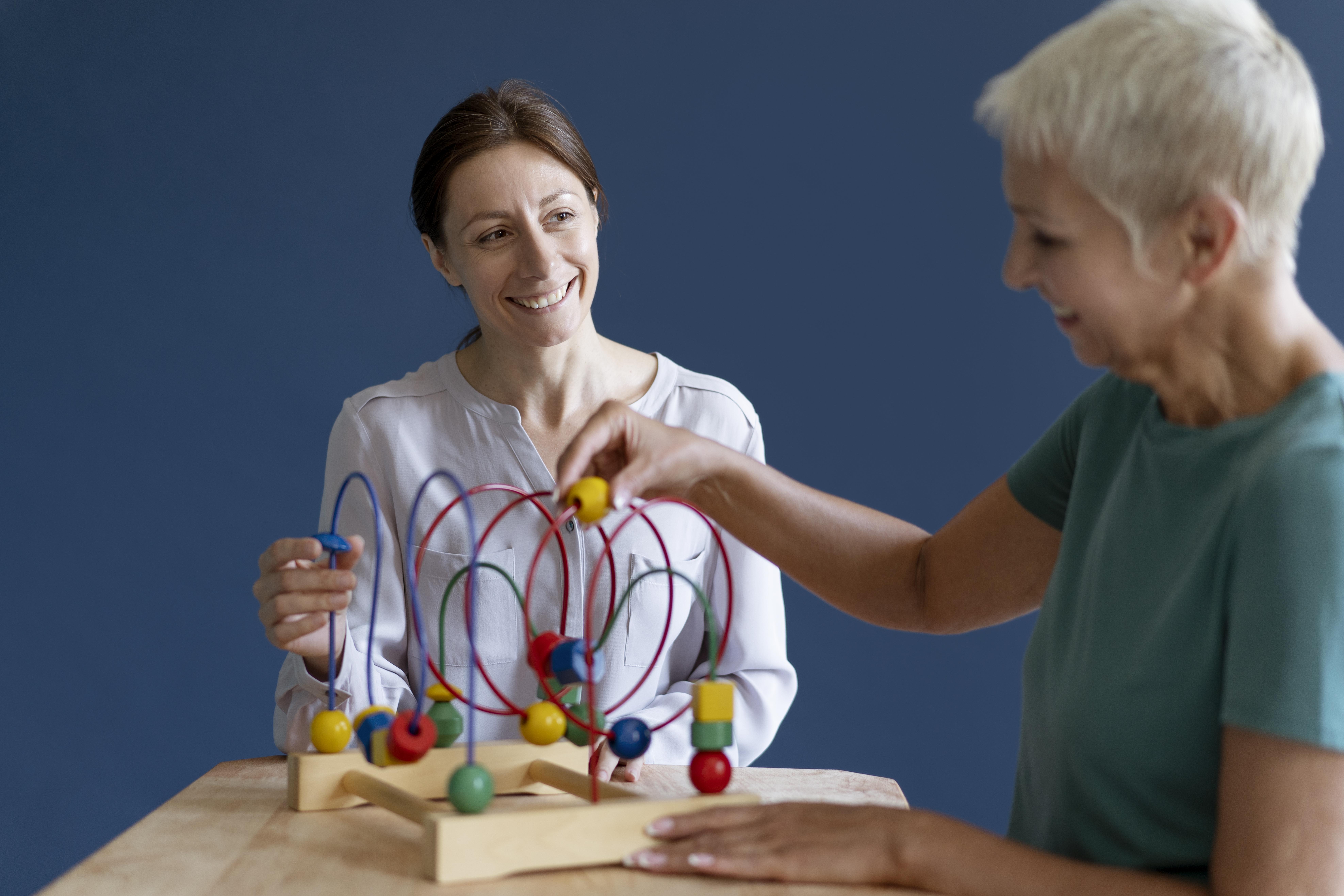Occupational Therapy Services
What Is Occupational Therapy?
An occupational therapist helps people of all ages overcome challenges completing everyday tasks or activities – what we call ‘occupations’. That could mean helping you overcome challenges learning at school, going to work, playing sport or simply doing the dishes. Everything is focused on your wellbeing and your ability to participate in activities.
It’s also a science-based, health and social care profession that’s regulated by the Health and Care Professions Council.
Occupations are essential to living.

An occupation is any activity that we need, want or like to do to live and to look after our physical and mental health, and our emotional and spiritual wellbeing. They give our lives meaning, purpose and structure. They help shape who we are, connect us with others and help create our identity and sense of belonging. Through occupation we enhance our health and quality of life.
We do occupations from the moment we’re born on our own or with others. Occupation isn’t just your job or activities of daily living. An occupation can be self-care, such as washing, eating or sleeping; productive, such as work, study, caring or domestic activities; and leisure, such as playing sports, hobbies or socialising.
We’re all different and so are the occupations that matter to us. They vary depending on our environment, interests and values, talents and skills. Our occupations also change throughout our lives.
Focusing on occupation leads to improvements in our ability to do the things we need and want to do, our social relationships, communication and connections as well as our mood, rest and sleep.
Occupations are particularly important when we’re going through times of change. When we can’t do an occupation anymore or we need to adjust the way we do it, because of ill health or other barriers, our sense of self and purpose may change.
This is where occupational therapy comes in.
(Royal College of Occupational Therapists, 2025)
Occupational Therapy with Neurodivergent
Children & Young People
Occupational therapy for neurodivergent children and young people is a personalized process that identifies individual strengths and challenges related to sensory processing, daily living skills, and social participation, often using a neurodiversity-affirming approach. Therapists create accessible, interest-based environments and tailor strategies to support self-regulation, communication, and independence by adapting routines, providing assistive equipment, and collaborating with families and schools, rather than solely focusing on changing the child to fit neurotypical norms.

The Neurodiversity-Affirming Approach
Focus on Strengths: Instead of solely addressing perceived deficits, OTs identify and build upon the neurodivergent child's unique strengths and talents.
Support, Don't Cure: The goal is to support neurodivergent individuals in their natural way of being, rather than trying to change or "fix" them to conform to neurotypical standards.
Respect Communication: Therapists are mindful of communication styles, support differences in social interaction, and may question social norms that pressure children to "mask" their natural behaviours.
Individualized Goals: Therapy is person-centred, with the child and family setting goals that are meaningful and important to them, such as improving self-care, social engagement, or participation in play.
Key Areas of Support
Sensory Processing: Therapists help identify sensory sensitivities (e.g., to textures, sounds, light) and provide strategies to create sensory-friendly environments at home and school.
Daily Living Skills: OTs support independence with everyday tasks like dressing, eating, hygiene, and handwriting by finding adaptive tools and modifying routines.
Social Participation: Support can include creating interest-based social opportunities, fostering secure attachments, and advocating for acceptance of diverse communication and socialization styles.
Self-Regulation: Therapists help children develop personalized self-regulation plans and strategies to manage emotional and sensory triggers, promoting a healthy balance of activities.
How It Looks in Practice
Assessment: The process begins with gathering information on the child's strengths, challenges, routines, and goals, followed by observations during various activities to understand their specific needs.
Environmental Adaptations: OTs work to remove environmental barriers by adjusting physical spaces, promoting inclusive routines, and reducing sensory overload.
Practical Tools: Recommendations may include assistive equipment like adaptive cutlery, writing aids, or sensory tools to support engagement in daily activities.
Collaboration: Therapists work closely with parents, caregivers, schools, and other professionals to ensure a comprehensive and supportive approach.
Activities: Therapy often uses games and activities tailored to the child's interests to build skills and promote engagement in a way that feels empowering and fun.

Occupational Therapy Assessment
At Autism Services Group, our occupational therapy assessments are designed to give a clear picture of individual strengths, challenges, and support needs. We understand that every child and adult on the autism spectrum is unique, which is why our assessments are personalized and comprehensive.
What is an Occupational Therapy Assessment?
An occupational therapy (OT) assessment looks at how a person manages daily activities, including:
Fine and gross motor skills (e.g., handwriting, balance, coordination)
Sensory processing and regulation
Self-care skills (e.g., dressing, eating, hygiene)
Play, social participation, and school readiness
Attention, focus, and functional independence
Why us?
Specialist knowledge of autism – Our OTs have extensive experience working with autistic children, adolescents, and adults.
Individualised recommendations – Each assessment leads to a tailored report with practical strategies and supports for home, school, or workplace.
Collaborative approach – We work closely with families, educators, and other professionals to ensure consistent and effective support.
What to Expect
Initial Consultation – We meet with you to understand your concerns and goals.
Assessment Sessions – Standardised tools, play-based activities, and observations are used to gain a full picture.
Comprehensive Report – You’ll receive a clear, accessible report with findings and recommendations.
Feedback & Planning – We’ll walk you through the results and discuss next steps for therapy, school supports, or daily routines.
Our occupational therapy assessments are suitable for:
Children showing delays in motor, sensory, or self-care skills
Autistic children and adults needing support with daily routines
Families seeking strategies to improve participation at home, school, or community
Teachers and workplaces needing tailored support recommendations
Our occupational therapy assessment includes a feedback virtual meeting with parents or caregivers, to go through anything they are unsure of and to discuss recommendations.
Sensory Profile Assessment
Many individuals with autism experience differences in how they respond to sensory input. Our sensory assessments help identify these patterns to better support comfort, regulation, and participation in daily life.
We assess:
Sensory Sensitivities – Reactions to sounds, textures, lights, smells, or movement.
Sensory Seeking/Avoidance – Behaviours that show a need for more or less stimulation (e.g., constant movement, covering ears, chewing non-food items).
Self-Regulation – Ability to manage emotions and behaviour in response to sensory input.
Impact on Daily Activities – How sensory differences affect learning, self-care, play, and social interaction.
Tools and methods may include:
Parent/caregiver questionnaires (such as the Sensory Profile).
Structured observations during play and daily tasks.
Standardised tests that measure sensory integration and processing.
Dyspraxia Assessment
Dyspraxia refers to difficulties with planning, sequencing, and carrying out coordinated movements. It can affect both gross motor skills (whole-body movement) and fine motor skills (hand control, writing, using utensils).
We assess:
Motor Planning Skills – Ability to conceptualize, organise, and complete new or complex tasks.
Coordination & Balance – Stability and control in body movement.
Hand-Eye Coordination – Skills needed for handwriting, drawing, and tool use.
Sequencing & Organisation – Following multi-step directions and planning tasks.
Impact on Independence – Challenges with dressing, eating, or participating in sports/play.
Tools and methods may include:
Standardised motor assessments (such as the Movement Assessment Battery for Children or Developmental Coordination Disorder Questionnaire).
Play-based and task-based observations (building, climbing, drawing, imitation tasks).
Family and teacher input on functional challenges in everyday environments.
Why These Assessments Matter
By identifying sensory processing patterns and motor planning challenges early, our team can:
Develop individualised therapy goals that are meaningful to the person and their family.
Recommend strategies and accommodations for home, school, and community settings.
Track progress over time and adjust support as needed.
Frequently Asked Questions (FAQ)
What is the role of an Occupational Therapist?
Occupational Therapists (OTs) help individuals build skills needed for everyday life such as self-care, social participation, sensory regulation, and learning. Our goal is to increase independence, confidence, and quality of life.
How do I know if my child needs an OT assessment?
Some common signs that an OT assessment may be helpful include:
Difficulty with dressing, eating, or other daily routines.
Sensory sensitivities (e.g., covering ears, refusing certain textures, seeking constant movement).
Challenges with coordination, balance, or handwriting.
Trouble following multi-step directions or organising tasks.
Avoidance of play activities that require motor skills.
What happens during an OT assessment?
The assessment usually includes:
A parent/caregiver interview to understand history, strengths, and challenges.
Functional analysis of play-based or leisure-based tasks to measure skills.
Observation of how the child responds to sensory input, motor challenges, and daily tasks.
A written report with recommendations and a personalized therapy plan.
How does OT help with sensory processing?
If a child is sensitive to sounds, lights, or textures—or seeks out constant movement—OTs use sensory integration strategies to help regulate these responses. This may include activities in a sensory gym, calming strategies, or environmental adjustments at home and school.
What is dyspraxia, and how does OT help?
Developmental co-ordination disorder (DCD), also known as dyspraxia, is a condition affecting physical co-ordination. It causes a child to perform less well than expected in daily activities for their age and appear to move clumsily. (NHS, 2023).
Children with dyspraxia experience difficulties with motor planning figuring out how to move the body to complete a task. An OT helps by breaking tasks into smaller steps, practicing motor skills through play, and teaching strategies that improve independence in activities like dressing, handwriting, and sports.
How often will my child need therapy?
The frequency of therapy depends on each individual’s needs. Some children benefit from weekly sessions, while others may need more intensive support at first and then transition to less frequent visits. Our team will make recommendations after the initial assessment.
Do you involve parents and caregivers in therapy?
Absolutely. Family participation is key to success. We provide strategies, training, and activities that parents can use at home and in the community to support their child’s progress.
Do you go to my child’s school?
Yes, we do. With your consent, we can liaise with the SENCO or Headteacher of your child’s school to undertake observations, which will form part of their occupational therapy assessment. It is a good idea to observe your child in different environments, to gain a more robust and holistic picture of their functional skills and identify any potential barriers to occupational engagement.
If you have any other questions, please contact the team on +44 7476 559894 or via our online contact form.
Your Journey. Our Support.
© 2025 Autism Services Group Ltd. All rights reserved.

